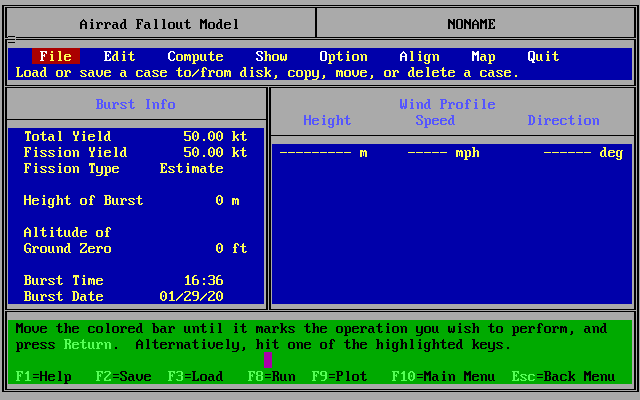|
Software of |
|
Software of |
This page contains official and non official software related to calculating weapons effects and such for World War III.
IMPORTANT NOTEAll of these programs are MS-DOS programs, and must be run in a DOS emulator, such as DOSBox (LINK) |
MARCH 2024 NOTEI've implemented a simple JS-DOSv7 installation on General Staff to enable you to run the software on this page within your browser for “on the go” computing of World War III. Simply click on the “RUN IN BROWSER” link(s). |
This program, as you can see from the title page, was originally written for the Defense Nuclear Agency (DNA).


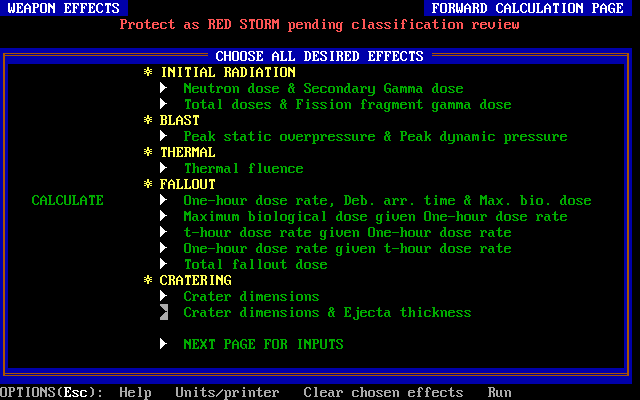
This program, as you can see from the title page, was originally written for the Defense Nuclear Agency (DNA).
IMPORTANT NOTEThis program must be run from B:\ Drive in DOSBox. Otherwise it will fail to execute properly. |
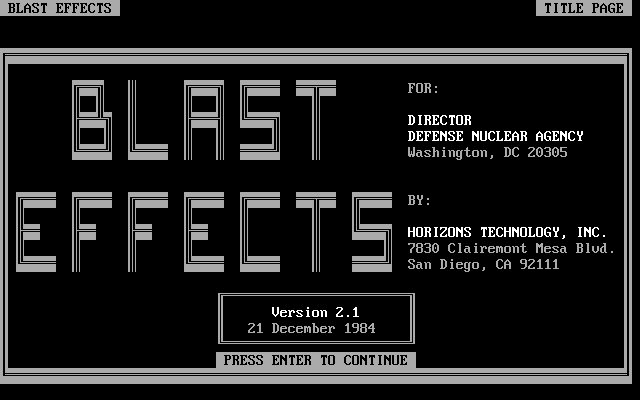
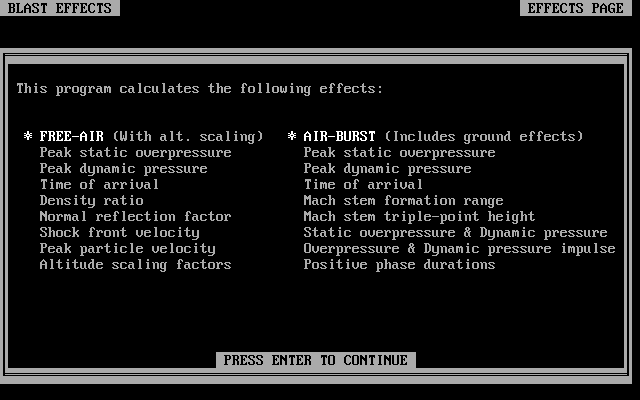
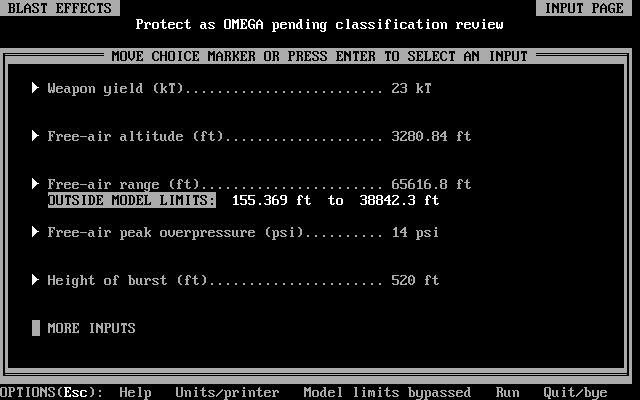
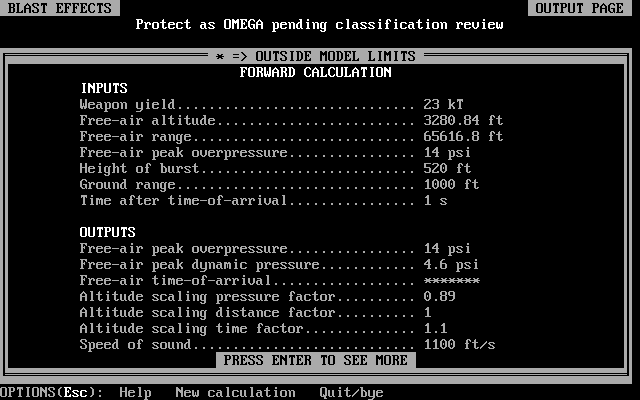
NOTE on WEAPON EFFECTS and BLAST EFFECTS: In the spring of 1992, Tony Frederickson and Ed Tremba of the Defense Nuclear Agency were chartered to assemble a set of numerical models of nuclear weapon effects from Capabilities of Nuclear Weapons in a usable computer program format.
They set up the Model Development Working Group (MDWG) consisting of Ed Tremba of DNA, Tom Dowler of LANL, Jim Drake of ARA, Archie Farnsworth of SNL, Ted Harvey of LLNL, Rob Managan of LLNL, Rob Managan of LLNL, Shel Schuster of TRT, Dev Srinivasa of RDA, Bill Woolson of SAIC, Joe Zelasko of WES, and A. V. Cooper of Titan who also wrote the resulting computer code, appropriately named NEMESIS (Nuclear Effects Models for Estimating Sensitivities to Input Scenarios): Anne V. Cooper, et al., NEMESIS - Nuclear Effects Models for Estimating Sensitivities to Input Scenarios, report WES-CR SL-95-1, February 1995.
NEMESIS includes air blast, cratering, ejecta, fallout, radiation, thermal and ground shock algorithms and replaces the obsolete computer programs called 'Blast Effects' and 'Weapons Effects' which were developed in December 1984 by Horizons Technology, Inc., of California for the Defense Nuclear Agency.
This program was written by Ruben Hamilton in 1991 using public data available in the Department of the Army Pamphlet 50-3: The Effects of Nuclear Weapons.

Originally, it was available at http://www.wasmerconsulting.com/airrad.htm; but this link went dead sometime after 2005. You can recover it through this WayBack Machine LINK.
According to that link:
“Airrad is an MS-DOS application that predicts radioactive fallout from a nuclear weapon detonation. It has the ability to...
Compute a variety of fallout hazard indicators, including normalized dosage rate, integrated dosage, and approximate times of beginning and ending of fallout.
Calculate the integrated dosage experienced by a moving point target traveling through the fallout area.
Calculate and report all hazard indicators at a user-defined set of points.
Create a contour plot for any selected hazard indicator and time.
Produce a report that details the various stages of computation, giving computed parameters, including predicted condition inside the fireball. View sample report.
Estimate unknown fission parameters and missing wind profile data.
The development of Airrad was sponsored by Sandia National Laboratories, Albuquerque, New Mexico, and the United States Army Atmospheric Sciences Laboratory, White Sands Missile Range, New Mexico.
Airrad's mathematical model is based upon Simfic, an earlier fallout prediction program developed by Hillyer G. Norment in 1979. Several improvements to the underlying model were made.”
Documentation and Sources recovered through the WayBack Machine are:
README File (HTM LINK)
Airrad Computational Engine (61 kb ZIP) (Computational Engine Documentation HTML)
ANSI C Source Code for Airrad Computational Engine – The original version of Airrad was written in Pascal. The computational engine was later translated into an ANSI C library that can be embedded into another program.
Airrad Fallout Prediction System User's Manual, Fred Wasmer, Unpublished Report to Sponsors, January 1989. (3.68 MB PDF)
This document describes the Airrad user interface in detail. Operation of the model is described from a user's point of view.
Airrad Fallout Prediction System Technical Report, Fred Wasmer, Unpublished Report to Sponsors, January 1989. (2.92 MB PDF)
This document presents a discussion of the physical basis of the Airrad fallout prediction system. The equations and algorithms used to model the fallout process are described. Discussion of theory and implementation are presented where appropriate.
Airrad Fallout Prediction System Model Validation Report, Fred Wasmer, Unpublished Report to Sponsors, January 1989. (1.37 MB PDF)
This document presents the results of a validation study for the Airrad fallout prediction system performed by Fred Wasmer in January, 1989. Airrad predicted fallout footprints are compared against measured fallout footprints for twenty test blasts in Nevada and the Pacific with yields ranging from 0.021 kilotons to 3.38 Megatons. The predicted and measured H + 1 hour normalized exposure rate footprints were qualitatively compared using contour plots. The areas inside selected contours were quantitatively compared. Acceptable performance was noted over the entire range of yields.
Testing of the Airrad Fallout Prediction Code, Mathias J. Sagartz, Sandia National Laboratories, Sandia Report SAND97-2613, October 1997. (4.99 MB PDF)
This document presents the results of a validation study for Airrad performed by Mathias J. Sagartz of Sandia National Laboratories in 1997. Abstract: "The origin and basis for the Airrad fallout prediction code are reviewed. The model on which Airrad is based is described and an earlier implementation of that model, the Simfic code, is reviewed. A detailed comparison of Simfic and Airrad is presented. Three fallout prediction codes, Airrad, Simfic, and Newfall, are exercised to calculate 1 hour normalized does rates for simple test cases and for five nuclear tests conducted in the atmosphere. The results are used to produce a series of contour plots which provide a basis for comparing the codes with each other and against the data for the five atmospheric tests. The report concludes that the current version of the code is a faithful implementation of its underlying model and that its fallout predictions of atmospheric test results are as good or better than the other codes."
